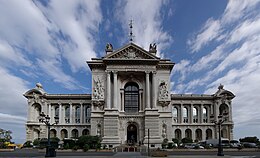Oceanographic Museum Monaco
Coordinates: 43 ° 43 ′ 50.2 " N , 7 ° 25 ′ 32.2" E
The Oceanographic Museum of Monaco ( French .: Musée et Institute Oceanographic de Monaco ) is a 1889 by I Prince Albert founded Monegasque Museum and Institute of Oceanography .
location
The Oceanographic Museum is located on a cliff in Monaco-Ville that extends into the Mediterranean . It was built in the midst of a prestigious park that is directly connected to the area of the Palais de Monaco , the residence of the Prince of Monaco. In the park, which is characterized by many exotic plants, there is a memorial for the founder, Prince Albert I , who is interested in oceanography, in the immediate vicinity of the museum .
history
Prince Albert I , known as the prince navigateur , had the Oceanographic Museum built on the slope of Monaco-Ville in 1899. He had brought various oceanographic objects from his expeditions to Monaco as souvenirs and research pieces and now had the desire to present them to the citizens in an elegant ambience. Among them was the sensational find of a Lepidoteuthis grimaldii (recovered from the vomit of a harpooned sperm whale on the occasion of a research trip in 1895), named after his family Grimaldi . He also took the view that in the coastal town of Monaco, a museum of oceanography would be a museum of local history , which could illustrate the local marine flora and fauna .
It was financed by the Albert Ier Foundation , whose assets resulted from Prince Albert's donations and which fell to a minimum as a result of the decline in the value of money. The foundation, which has owned the museum since 1906, is registered in France, so the Oceanographic Museum in Monaco is formally a French one. However, according to the foundation's statutes, the ruling Prince of Monaco is always chairman of the Albert Ier Foundation .
At the opening of the imposing building, at which both an envoy from the French Republic and the friendly German Empire (Albert I and Kaiser Wilhelm II were good friends, not least because of their maritime interests), Prince Albert I announced:
- “ Here, gentlemen, you can see how the Monegasque earth gave rise to a proud and inviolable temple dedicated to the new deity who rules over intelligence. "
In 1906, the Oceanographic Institute finally began its research activities under its first director, Louis Joubin , a French zoologist for marine molluscs and the first to describe Lepidoteuthis grimaldii.
In 1957 Jacques-Yves Cousteau became director of the museum. Under his care the museum and especially the research area in the institute flourished again. Today the Oceanographic Museum has modern aquariums and is almost entirely self- financed by tourism .
In 2002, the Monaco Oceanographic Museum became an official partner organization of the Convention for the Protection of the Whales of the Black Sea, Mediterranean and Adjacent Atlantic Zones ( ACCOBAMS ).
In 2006 Prince Albert II established a foundation named after him ( Fondation Albert II de Monaco ) for the protection and preservation of nature in the Arctic . He would like to continue the work of his namesake and ancestor.
A lionfish in an aquarium at the Monaco Oceanographic Museum
Web links
- Official website of the Oceanographic Museum of Monaco (French, English)
- The Monaco Oceanographic Museum . In: VisitMonaco.com
Individual evidence
- ↑ Joubin, L .: Cephalopodes provenant des campagnes de la Princesse-Alice (1891-1897). Result of the Campagnes Scientifiques accomplies sur son yacht par Albert Ier Prince Souverain de Monaco. 17: 1-135 (1900) Archived copy ( Memento of the original dated February 3, 2009 in the web archive archive.today ) Info: The archive link was inserted automatically and has not yet been checked. Please check the original and archive link according to the instructions and then remove this notice.








